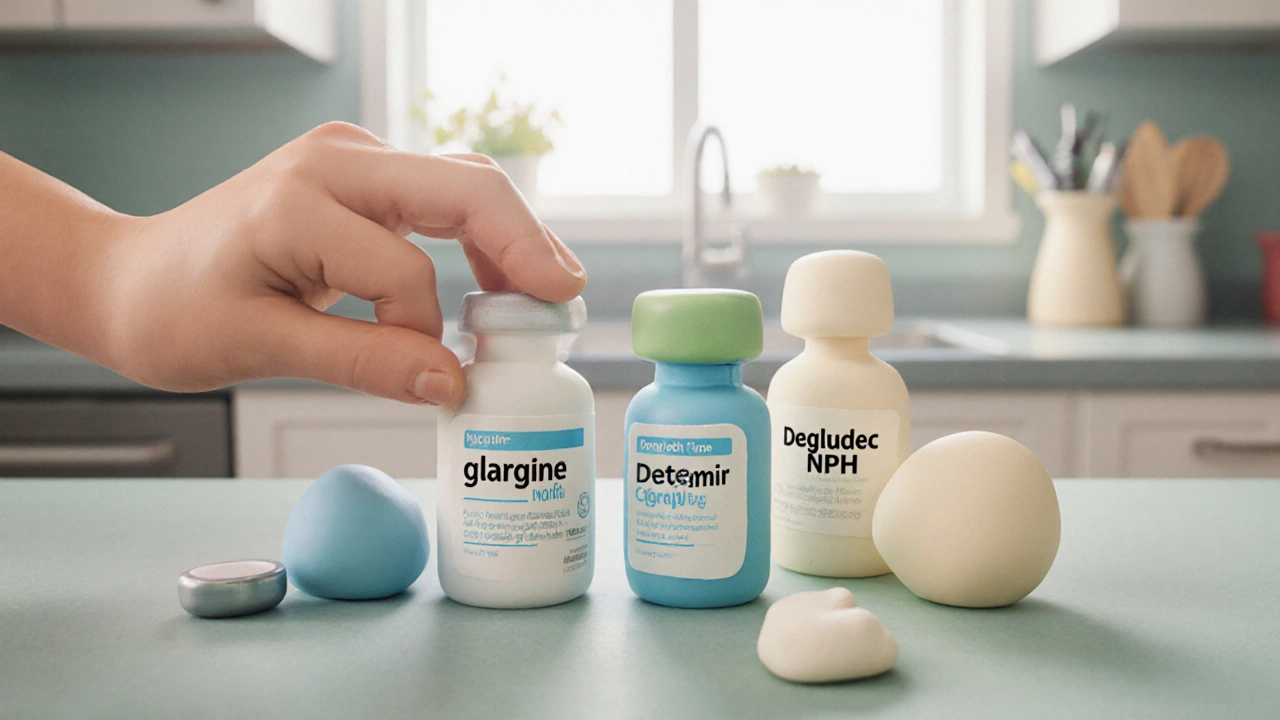Basal Insulin Comparison Tool
Find Your Best Basal Insulin Match
Answer these questions to see which long-acting insulin aligns best with your priorities.
Recommended Insulin
Select your priorities and click "Find My Match" to see your recommended insulin
When it comes to keeping blood‑sugar levels steady overnight, the choice of basal insulin can feel overwhelming. Insulin Glargine is a synthetic, long‑acting insulin analogue that many clinicians prescribe for both type 1 and type 2 diabetes. But it’s not the only player on the field. In this guide we break down how insulin glargine stacks up against its main competitors - insulin detemir, insulin degludec and the older NPH insulin - so you can see which fits your lifestyle, budget and clinical goals.
How Basal Insulins Work: The Basics
All basal insulins aim to mimic the body’s background insulin secretion, preventing high glucose levels between meals and overnight. The key differences lie in their pharmacokinetic profiles - how quickly they start working, how long they stay active, and how predictable their effect is. Understanding these attributes helps you match an insulin to your daily routine and your body’s response.
Insulin Glargine - What Makes It Unique?
Insulin Glargine is a recombinant human insulin analogue engineered to form micro‑precipitates in subcutaneous tissue. This slow‑release mechanism provides a relatively flat 24‑hour insulin level with no pronounced peak.
- Onset: 1-2 hours
- Peak: None (peak‑less)
- Duration: Up to 24 hours
- Typical dose range: 0.2-0.5 U/kg per day
- Common side effects: Hypoglycaemia (especially if dosing is too aggressive), injection site redness
- Regulatory status: Approved by FDA (1999) and EMA (2000)
Because of its steady profile, many patients only need one injection a day, which can simplify life‑style management.
Insulin Detemir - The “Half‑Life” Contender
Insulin Detemir binds tightly to albumin, slowing its absorption. Its slightly shorter duration means some people require twice‑daily dosing.
- Onset: 1-2 hours
- Peak: Minimal, but a modest peak may appear around 6-8 hours
- Duration: 12-18 hours (dose‑dependent)
- Typical dose: 0.1-0.5 U/kg per day
- Side effects: Similar to glargine, with a modestly lower risk of nocturnal hypoglycaemia
- Cost: Generally 10‑15 % cheaper than glargine in the UK
Detemir’s flexibility can be an advantage for people who struggle with a once‑daily injection schedule.
Insulin Degludec - The Ultra‑Long‑Acting Option
Insulin Degludec forms multi‑hexamer chains that dissolve very slowly, delivering an ultra‑flat profile that can last up to 42 hours.
- Onset: 30-90 minutes
- Peak: None (exceedingly flat)
- Duration: Up to 42 hours
- Typical dose: 0.1-0.5 U/kg per day
- Side effects: Low nocturnal hypoglycaemia, but higher cost
- Special note: Allows flexible dosing times - you can shift the injection window by several hours without losing control
Degludec is often favoured for patients with highly variable schedules or those who have experienced frequent lows on other basal insulins.

NPH Insulin - The Legacy Basal
NPH Insulin (Neutral Protamine Hagedorn) has been used for decades. It’s an intermediate‑acting insulin that peaks around 6-10 hours and usually lasts 12-18 hours.
- Onset: 1-3 hours
- Peak: Prominent at 6-10 hours
- Duration: 12-18 hours
- Typical regimen: Often twice‑daily
- Side effects: Higher risk of both daytime and nocturnal hypoglycaemia due to pronounced peak
- Cost: Cheapest basal insulin on the market
Because of its peak, NPH can be useful for patients who need a pronounced insulin effect at a specific time, such as early morning.
Decision Criteria - How to Choose the Right Basal
When comparing insulin glargine to its alternatives, consider the following factors:
- Injection frequency: If you prefer a single daily shot, glargine or degludec are strong candidates. Detemir may need two doses.
- Risk of hypoglycaemia: Degludec and detemir show slightly lower nocturnal lows than glargine. NPH carries the highest risk.
- Cost and insurance coverage: NPH is the cheapest; glargine and detemir are moderate; degludec is premium.
- Flexibility: Degludec allows you to shift injection times without losing efficacy. Glargine is more rigid.
- Clinical goals: For tight HbA1c targets, the flatter profile of glargine or degludec can make fine‑tuning easier.
- Patient lifestyle: Shift workers, frequent travelers, or those with unpredictable meals may benefit from degludec’s extended window.
Discuss these points with your diabetes team - they’ll weigh lab results, comorbidities and personal preferences to land on the best match.
Side‑by‑Side Comparison Table
| Insulin | Onset | Peak | Duration | Typical Dose Frequency | Hypoglycaemia Risk | Relative Cost (UK) |
|---|---|---|---|---|---|---|
| Glargine | 1-2 h | None | Up to 24 h | Once daily | Moderate | Medium |
| Detemir | 1-2 h | Minimal (6-8 h) | 12-18 h | Once or twice daily | Low | Low‑Medium |
| Degludec | 30‑90 min | None | Up to 42 h | Once daily (flexible) | Very low | High |
| NPH | 1-3 h | Pronounced (6-10 h) | 12-18 h | Twice daily | High | Very low |
Notice how the ultra‑long profile of degludec stands out - it’s the only insulin that can comfortably stretch beyond a 24‑hour window.

Real‑World Scenarios
Scenario 1 - A 28‑year‑old nurse working rotating shifts: She needs an insulin that won’t “break” if she injects at 10 pm one night and 6 am the next. Degludec’s 42‑hour window lets her shift the dose without spikes.
Scenario 2 - A 62‑year‑old retiree on a fixed budget: Cost matters most. NPH provides reliable basal coverage at the lowest price, but she must be diligent about timing to avoid early‑morning lows.
Scenario 3 - A newly diagnosed type 2 diabetic preferring simplicity: One daily injection with a flat profile is appealing. Glargine offers that balance of predictability and convenience.
Scenario 4 - A patient with frequent nocturnal hypoglycaemia on glargine: Switching to detemir or degludec, both linked to lower overnight lows, can reduce emergency trips.
These examples illustrate that the “best” basal insulin hinges on individual circumstances, not a universal ranking.
Tips for a Smooth Transition Between Basals
- Start with a 10‑20 % dose reduction when switching to a longer‑acting insulin to mitigate low‑blood‑sugar risk.
- Monitor fasting glucose daily for at least two weeks after the change.
- Adjust mealtime insulin doses only after the basal has stabilized.
- Keep a log of injection times, doses, and any hypoglycaemic events - this data helps your clinician fine‑tune the regimen.
- Consider using a continuous glucose monitor (CGM) during the transition for real‑time feedback.
Patience pays off - it can take 1‑2 weeks for the new basal to reach steady‑state levels.
Bottom Line
If you value a single daily shot and a well‑studied safety record, insulin glargine remains a solid choice. For those who need extra flexibility or have experienced nighttime lows, insulin degludec or detemir may edge ahead. And when cost constraints dominate, NPH still delivers reliable basal coverage albeit with a higher hypoglycaemia risk. Talk openly with your diabetes team, weigh the criteria above, and you’ll land on the basal insulin that best fits your life.
Can I mix insulin glargine with rapid‑acting insulin in the same syringe?
No. Insulin glargine is formulated to form a stable depot; mixing it with rapid‑acting insulin can alter its absorption and reduce its long‑acting effect. Use separate injections.
Is insulin degludec safe for people with kidney disease?
Degludec is cleared mostly by the liver, so it’s generally safe for mild‑to‑moderate renal impairment. Still, dose adjustments and close glucose monitoring are advised.
Why does NPH insulin cause a “mid‑night crash” for some patients?
NPH has a pronounced peak 6‑10 hours after injection. If taken at dinner, the peak often lands around midnight, leading to low glucose if no snack is taken.
Do I need a different syringe for each basal insulin?
All three basal insulins are supplied in standard U‑100 pens or vials compatible with 0.3 mL (30‑unit) syringes. If you use a pen, the same device works for glargine, detemir and degludec.
How quickly does insulin glargine reach steady‑state levels?
Steady‑state is usually achieved after 3‑4 days of consistent daily dosing. That’s why clinicians often wait a week before making dose tweaks.


Jordan Levine
October 24, 2025 AT 18:11Glargine is the *real* hero of basal insulin 💥💉!
Carla Taylor
November 4, 2025 AT 13:23Great rundown love the clear tables
Michelle Capes
November 15, 2025 AT 08:35Thanks for the info 😊 i think it helps alot for newbies
Dahmir Dennis
November 26, 2025 AT 03:47Oh, how delightfully simple it must be to think that one basal insulin can solve every diabetic's woes. Because obviously, the human body loves being treated like a one‑size‑fits‑all machine. Glargine, with its so‑called flat 24‑hour profile, is hailed as the gold standard, yet it still leaves many patients battling nocturnal lows. Meanwhile, the newer degludec struts around with a 42‑hour window, as if longer automatically means better. And let’s not forget detemir, the modest middle child that sometimes needs a second shot, because why would anyone want consistency? The old NPH, bless its heart, still crawls around cheap as pennies, but its peak can turn a peaceful night into a hypoglycaemic nightmare. Physicians love to toss around terms like 'baseline' and 'steady‑state' while ignoring the messy reality of daily life. Patients juggling shift work, unpredictable meals, and insurance hoops deserve more than a glossy table. Sure, the tables show numbers, but they don’t capture the anxiety of waking up at 3 am to check a glucose that’s plummeting. If you’re lucky enough to have a CGM, you’ll see the micro‑fluctuations that none of these charts reveal. So before you crown any insulin as the universal champion, remember that individual response varies wildly. A drug that offers convenience for one person may be a source of terror for another. Cost, too, is a brutal factor – premiums like degludec can drain wallets faster than a sugar crash. In the end, the ‘best’ insulin is the one that fits your schedule, your budget, and your body’s quirky chemistry. Thus, let’s stop worshipping any single molecule and start listening to the real experts: the patients themselves.
Jacqueline Galvan
December 6, 2025 AT 22:59When transitioning between basal insulins, a 10‑20 % dose reduction is generally recommended to minimize hypoglycaemia risk. Monitoring fasting glucose daily for two weeks helps confirm steady‑state before adjusting mealtime insulin. Additionally, keeping a log of injection times and glucose readings enables your clinician to fine‑tune the regimen efficiently.